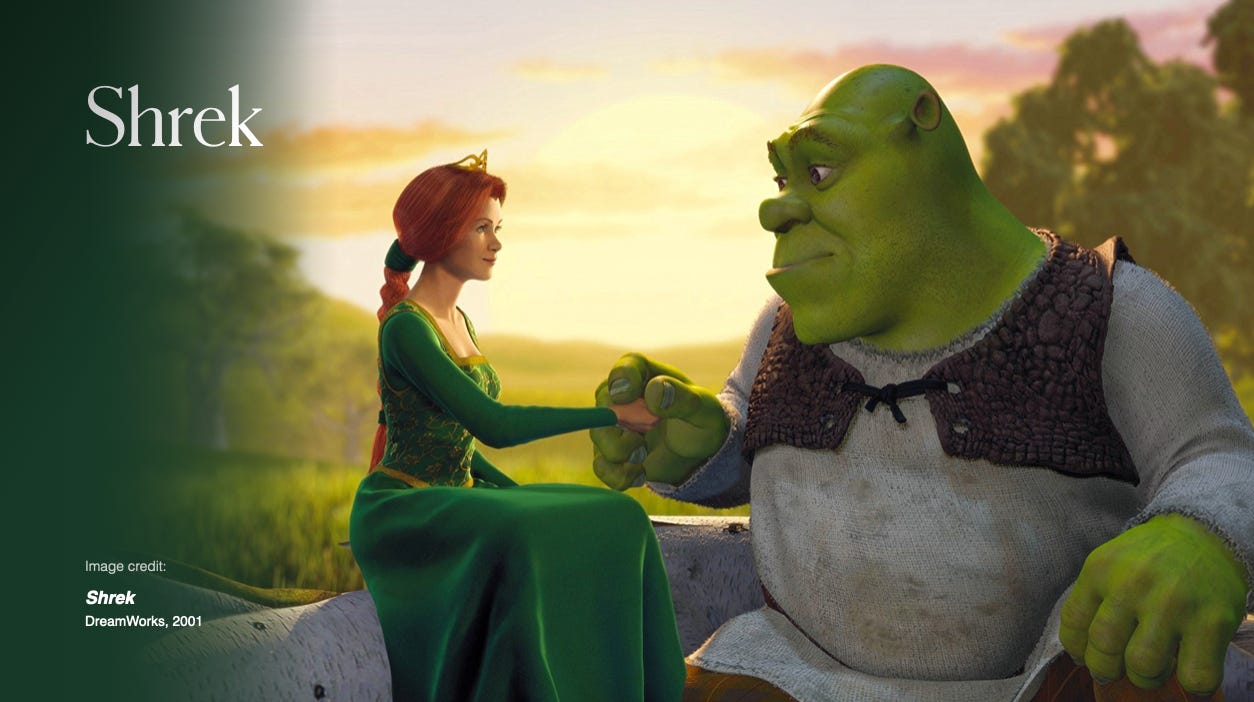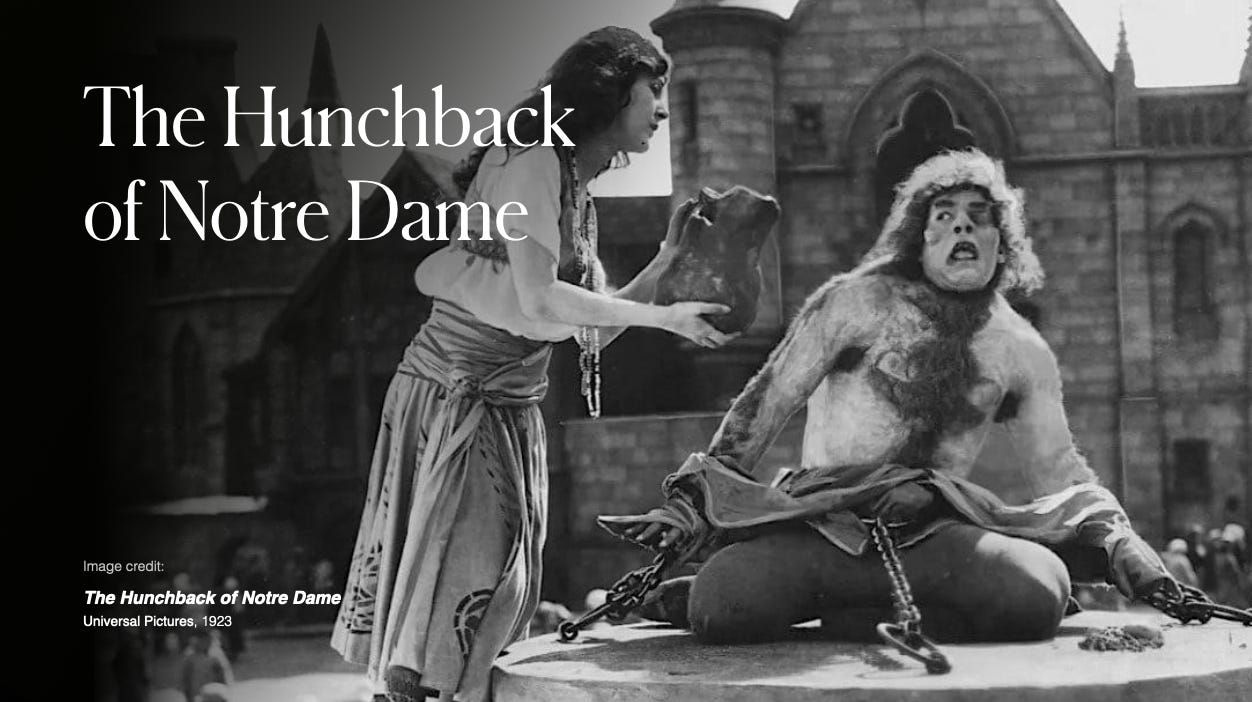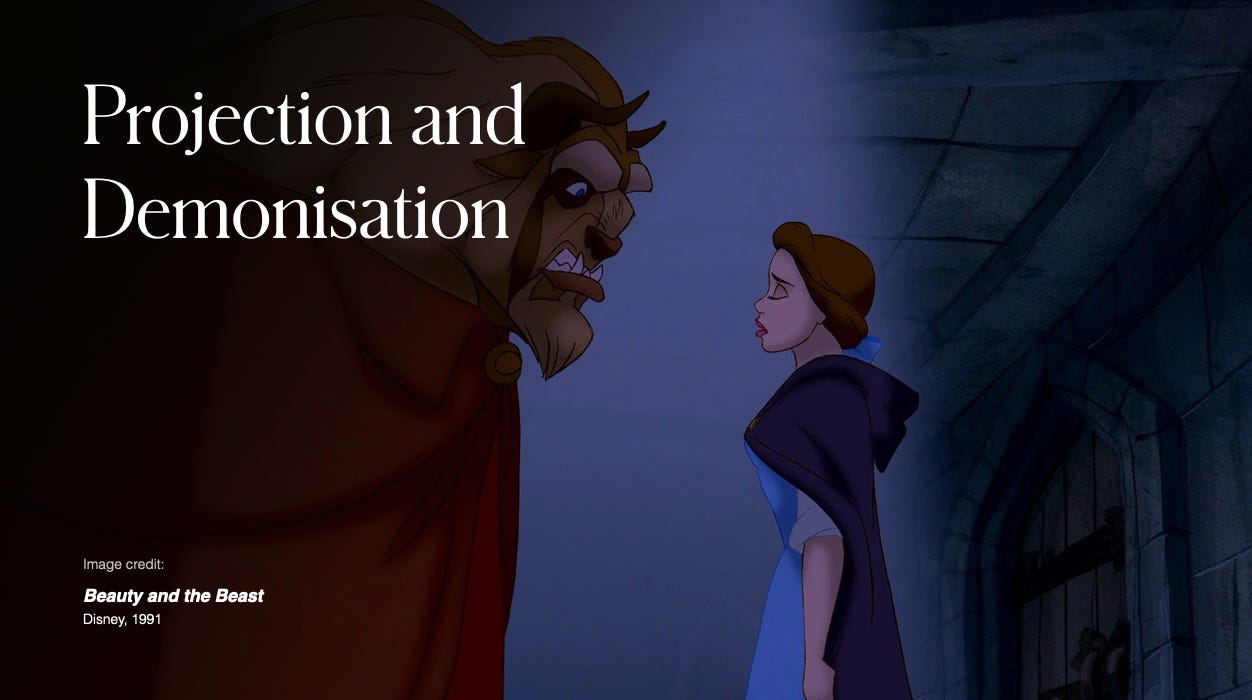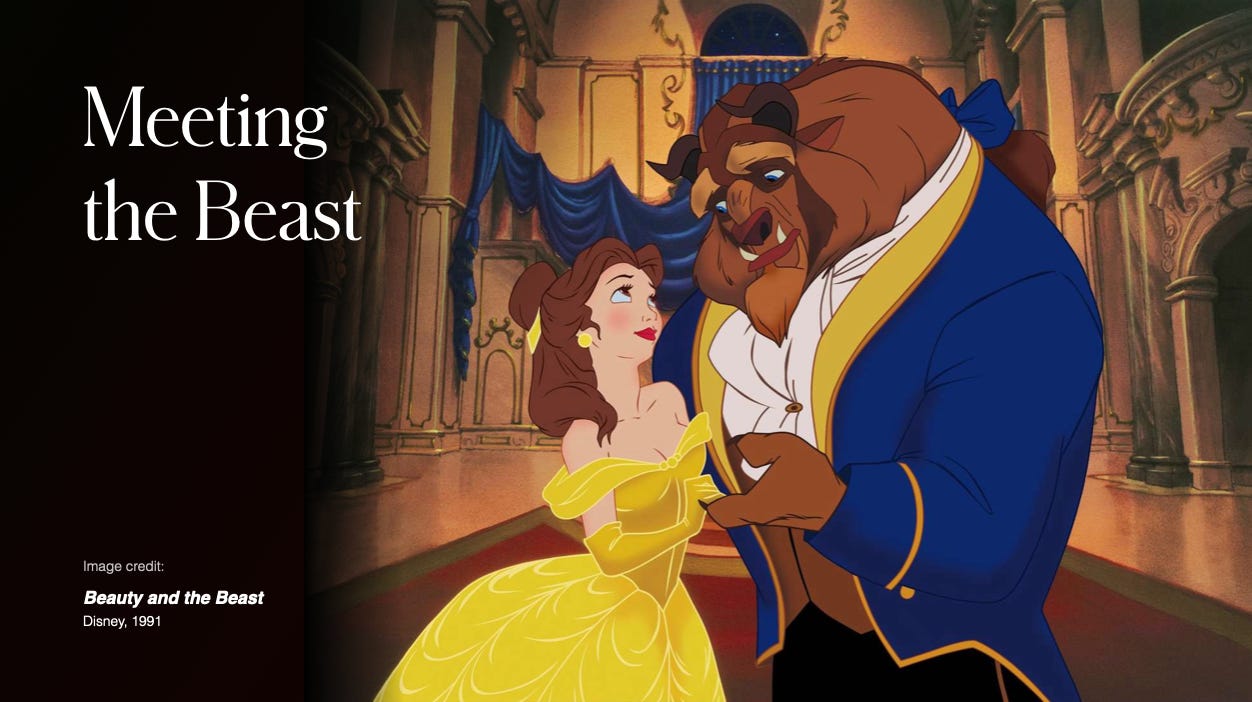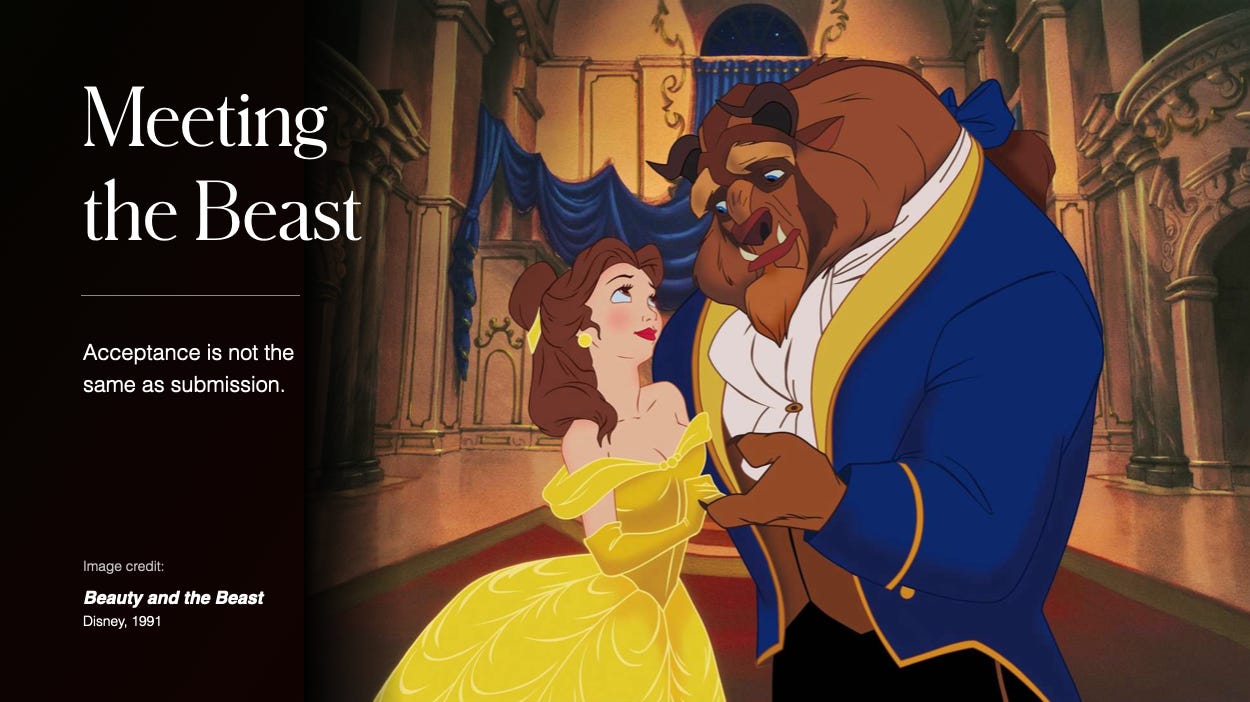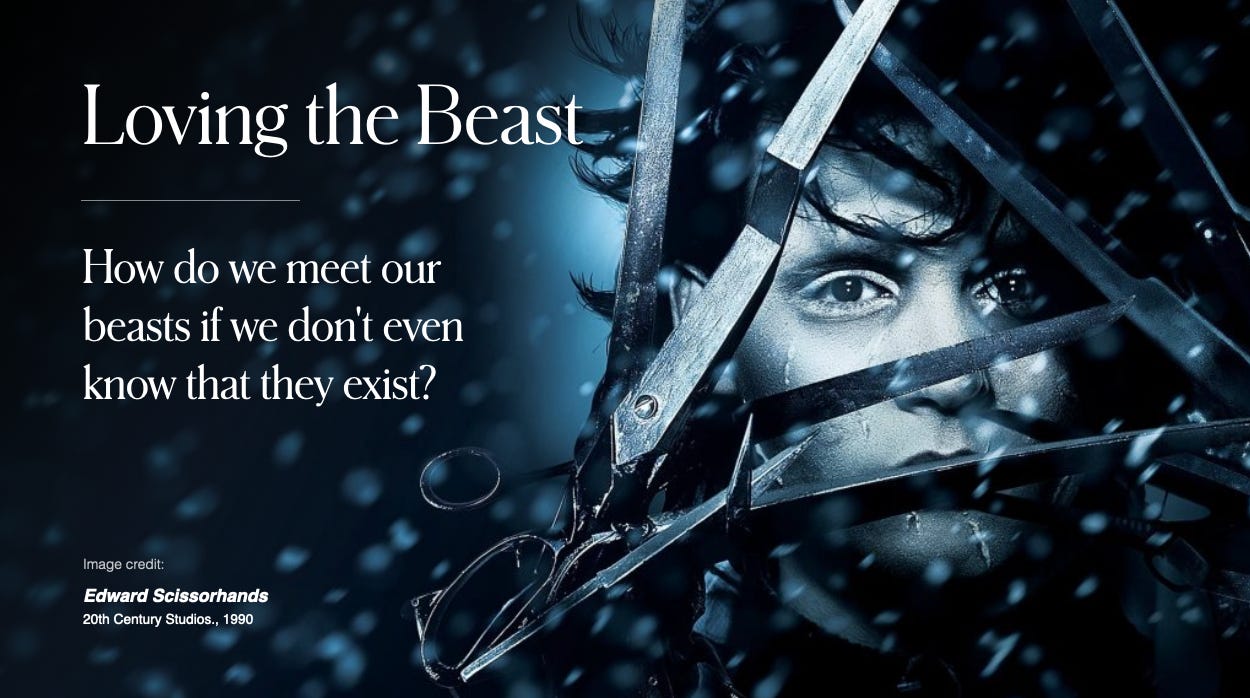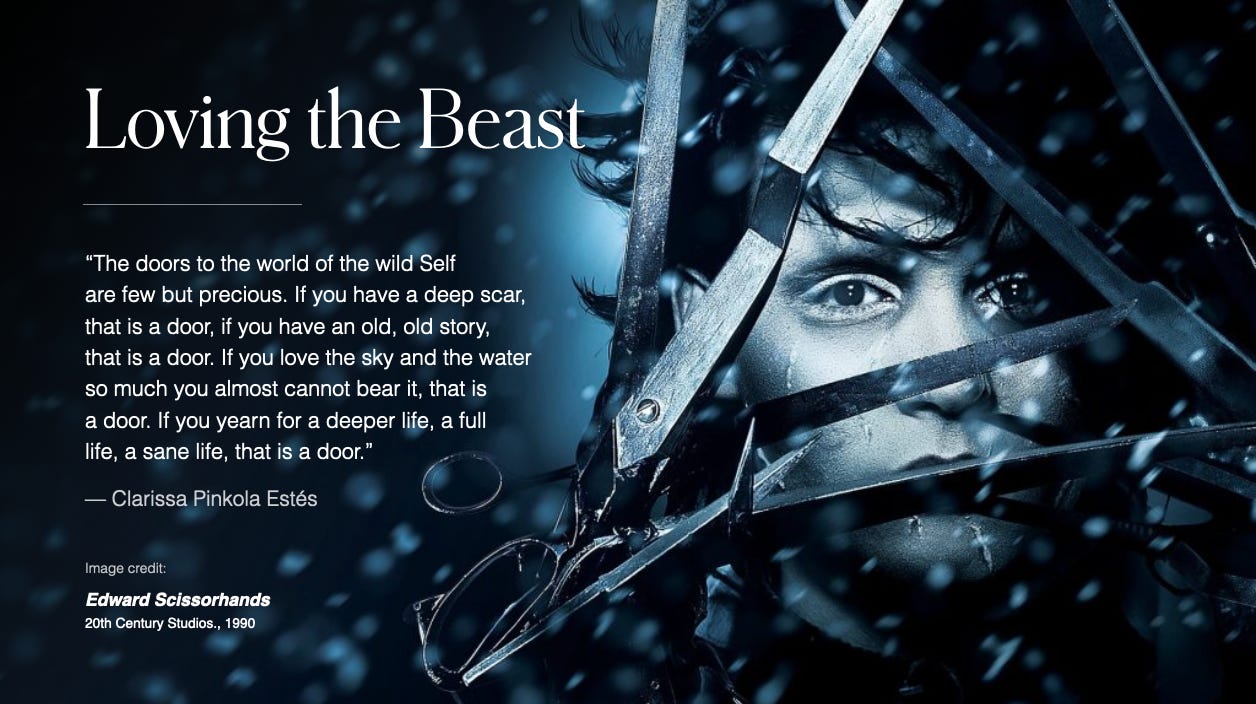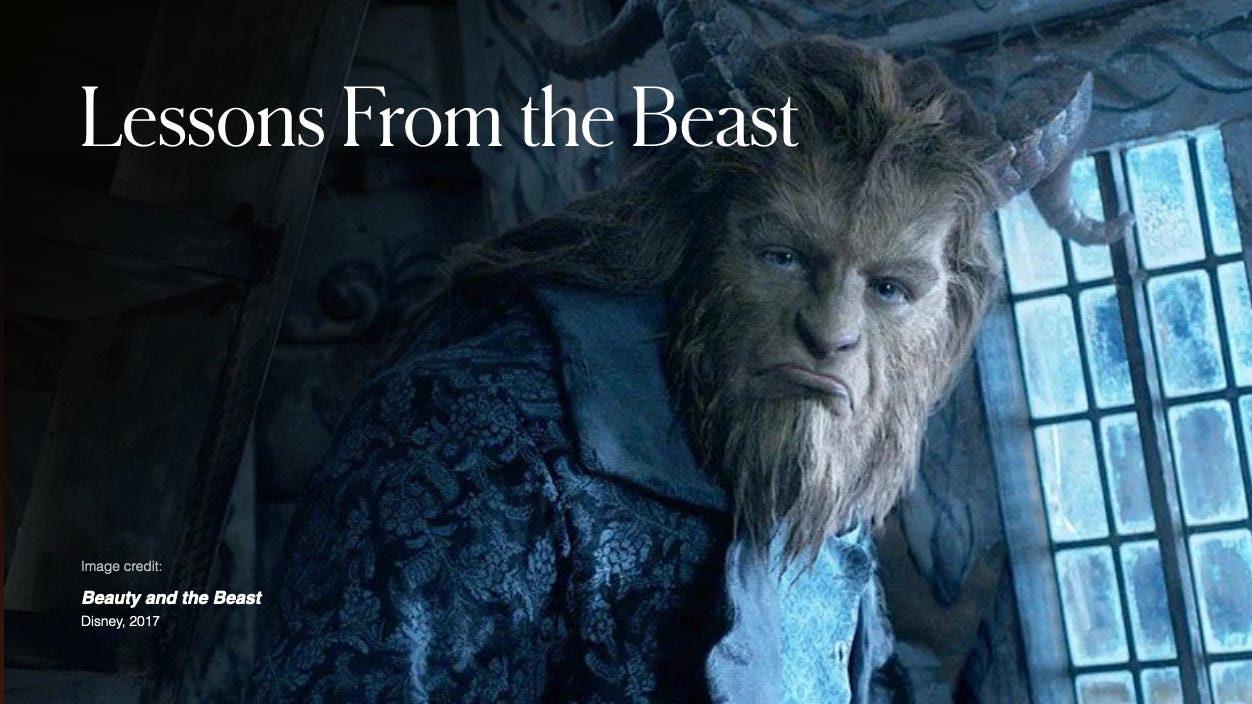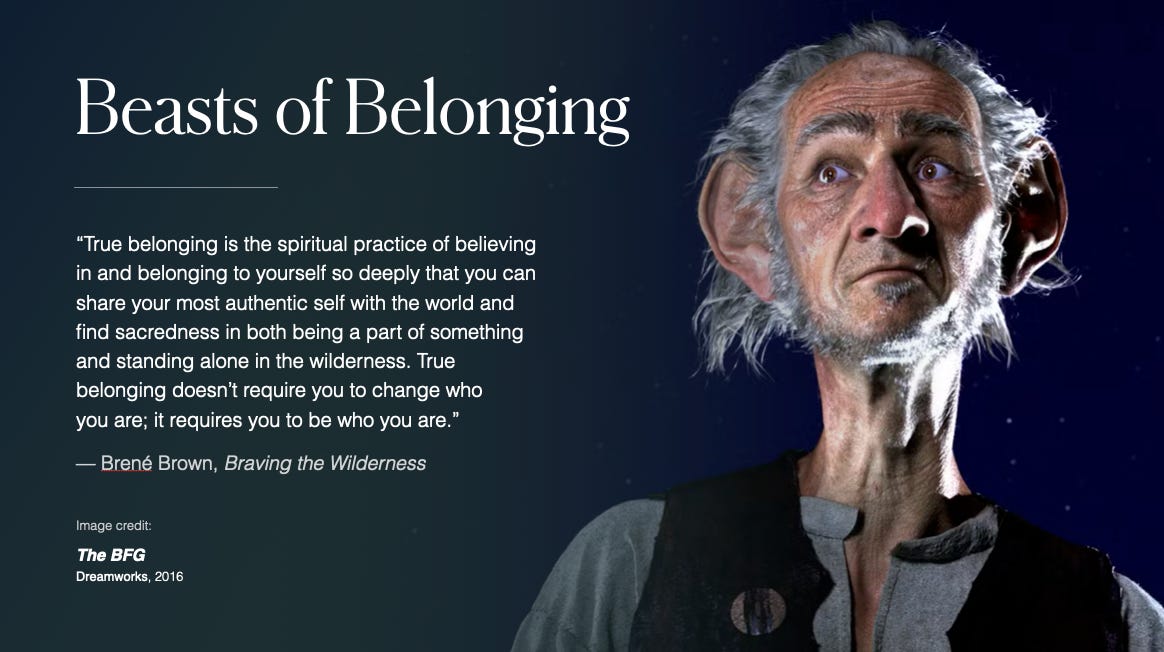Behold the Shadow Beast: How to love what we fear within (Menaces of the Mind #7)
Transforming shame through fierce self-acceptance
You can watch this piece on YouTube.
***
Here’s a thought: What if the most effective form of self-love isn’t at all what you’d expect? What if it has less to do with rituals, affirmations and forgiveness than it does with valour? What if the ultimate act of self-love simply involves the courage to stand in front of the parts of yourself that terrify you, and say, “I see you”?
The (shadow) beast as archetype
Some of the oldest stories we know – Eros and Psyche, Beauty and the Beast, The Hunchback of Notre Dame – begin with a dreadful creature: mysterious and terrifying and Other.
But then something happens – someone (often the heroine) dares to love the Beast, which breaks the curse, and the monster is transformed. It’s made whole, made… good.
Of course, we don’t only see this in old stories. The same pattern plays out in novel after novel, movie after movie: The BFG, Moby Dick, King Kong, Edward Scissorhands, Shrek.
Stories where the ‘monster’ is lovingly revealed to be more human than the humans who feared it get told over and over. It’s perhaps the simplest archetypal arc of all – radical acceptance creates the possibility of change. Or: Love heals.
Why do we love these beastly transformations?
Why does this storyline move us so much? Maybe it’s because, on some level, we know it’s not just about the Beast out there – it’s about the Beast in here.
When we watch a monster become loveable, something in us breathes a sigh of relief. We’re rehearsing, in story form, a transformation we long for inside ourselves: to take the parts of us that feel unworthy or unacceptable and see them embraced instead of exiled.
Neuroscience even shows that when we witness a story of any kind, our brains light up as if we are going on that journey – as if we are the protagonists, meaning that with a love-heals story, we get to practice integration by proxy. A similar thing happens when we engage with underdog stories – Million Dollar Baby, Rocky, The Shawshank Redemption. We root for the character the world sees as least worthy, because deep down we hope that our own rejected parts might turn out to be winners, too. These stories will enthrall us for as long as there’s shadow work to be done. In other words, until the end of time.
The shadow and the monster
The Jungian shadow self – as in, the collection of repressed traits, instincts, emotions, and memories within each of us – continues to accumulate stuff over the course of our lives. Anything can go in there, from shame and humiliation to stand-out strengths and feelings like love and joy. The only rule, when it comes to something’s relegation to the shadow, is that it doesn’t fit with the image of self we think we have to maintain in order to feel safe, or loved, or simply to survive.
The Shadow is the anger we were told was too dangerous, the need we were taught was selfish, the creativity, wildness, sexuality, ambition, or tenderness we feared might get us hurt.
People usually think of shadow work as a painful process of uncovering personal flaws – inner ugliness that we’ve locked away for good reason. And sometimes that will be the case, but more often than not, our shadow selves seem ugly only because we have forced them into the dark, where anything can look scary.
However, as the Dragon taught us, that fear is a signpost. It marks a threshold we must cross if we want to lay our hands on the treasure beyond. The threat of the Shadow Beast is what stands between a fractured self and an integrated whole.
Projection and demonisation
This monster makes tracks in the outer world as well as the inner, because whatever we won’t face in ourselves, we end up facing in the external world.
When we refuse to acknowledge our Shadow, we project it — we perceive “the Beast” in the outside world because we can’t bear to witness it within. If you care to look, it’s easy to see that the traits we hate most in other people — the ones we mock online, cancel, or rage against — are almost always the ones we refuse to see in ourselves. Social media is one huge projection machine, with every comment section a hall of mirrors.
But projection isn’t limited to obviously beasty traits. When we reject our own femininity, for example, we fall into misogyny. If we disown our creativity or strength or ambition, we’ll throw that out there too, and find ourselves consumed by intense jealousy, forced to live in an ostentatious world full of brilliant, powerful achievers that we feel we could never even hope to rival.
Ultimately, what we demonise in ourselves we’ll be fated to suffer in others, and whether we feel repulsion, rage, envy, fear or simple shame when we look at these other people flaunting what we’ve worked so hard to bury, that discomfort – that ugly, ugly feeling we get – is the growl of the Beast, asking to be recognised.
Meeting the beast
In Beauty and the Beast, the Beast transforms because Beauty chooses to see him and love him as he is.
Similarly, in the myth of Psyche and Eros, Psyche’s fear of the terrible monster she initially believes is holding her captive melts into love when she dares to shine a light on his true face.
Reading these motifs through a psychological lens, the message is simple (if not easy to follow): we cannot integrate what we refuse to see, so we must brave a look.
Loving the beast within
Seeing, accepting and loving the parts of ourselves that are hard to love doesn’t, however, mean indulging destructive urges. Acceptance is not the same as submission – it doesn’t mean obeying the Beast; it means giving it a chair by the fire so you can finally hear what it has been trying to say.
At first at least, loving our inner monsters is a matter of creating space for them:
To take the opportunity to feel and listen to our emotions, rather than numbing them away or rushing onto the next thing;
To give ourselves grace and permission to process difficult experiences such as grief, loss, heartbreak and anger, over time;
To welcome the wilder urges and instincts, the old wounds, the questionable ideas and unmet needs back into the fold by allowing them just a little attention.
So, it’s not about giving in to these difficult experiences, nor is it about following every whim. It’s about allowing them to exist, because our monsters are far more harmful when pushed away or ignored – they have more agency, more power and more control from the shadows than they ever can when we accept that they’re a part of us.
Most importantly, only once invited back can these exiled aspects of ourselves begin to work with us rather than against us, using their strengths and abilities to move towards a better self rather than continually regressing to a problematic past or pattern.
Loving the beast within
That all sounds great in theory, but the trickiest part is this: How are we supposed to open the door to these inner beasts if we’ve been denying them until now? If we don’t even know that they exist?
Well, one way is to pay attention to what we rail against, what we criticise or hate in others. Our projections will lead us to our Shadow Beasts, for sure.
What are the traits you find most insufferable in others – the most irritating, obnoxious, or rude?
Here’s the kicker: no trait is off the table for any of us. Even the most intelligent of people say something stupid from time to time. The kind can still be mean, the modest still pride themselves on something they do, and there’s not a person alive who has never acted selfishly or greedily. All these things are innate parts of being human. So, whenever we find ourselves seething or grimacing to witness someone else’s behaviour, it’s a good idea to pause and take a look in the mirror. We may well have our own Beast to behold.
But projection isn’t the only signpost. The truth is that none of us will ever fully know our shadow selves. For every monster we let back in, there are tens, hundreds, maybe more waiting in the dark. And that’s okay. Shadow work is not a computer game to complete and then replace with the next shiny title. Instead, it’s a way of life, and the universal key to accessing and integrating our various monsters is – bear with me here – pain.
As Clarissa Pinkola Estés writes in this beautiful passage, “The doors to the world of the wild Self” – aka the Shadow and all its potential – “are few but precious. If you have a deep scar, that is a door, if you have an old, old story, that is a door. If you love the sky and the water so much you almost cannot bear it, that is a door. If you yearn for a deeper life, a full life, a sane life, that is a door.”
In short, your emotions will show you the way. I have found myself close to tears a number of times while writing these latest articles. Not all of the monsters get to me, but a couple of them do every time I read through their scripts. Why? Because those ones touch something within me that still feels raw, that still needs a bit of work. Those will be the monsters I take to therapy, journal about, think about, talk about with friends, because my emotions have told me there’s something in them that I’m yet to process fully – something I’m yet to see.
When it comes to living a bigger, fuller life, pain is our most important teacher. But, before you run for the hills, this doesn’t mean signing up for a life of discomfort. It’s closer to the opposite, because just as with beasts and monsters, pain itself rings louder and feels more devastating when we try not to feel it more than it does when we let it in.
I’m not going to tell you to “welcome” all pain here because that kind of flippant BS isn’t going to help anybody, but I do believe we can benefit from the decision to be less afraid of it, less avoidant where we can. Sometimes, all it takes is five seconds to stop and say to yourself “Right now, I’m feeling shame” or “I’m noticing a feeling of fear”.
You can, of course, breathe into your emotions, sit with them for longer, write about them, talk about them, paint them, sing them… if you want. But it’s important to remember that you don’t have to do any of these things right away. Numbing and distraction are not good long-term strategies, but sometimes they’re needed at first, when the feeling is too big, or your life too busy. So please don’t beat yourself up for habits of avoidance either. You have all the time in the world to welcome your beasts back home.
Lessons from the Beast
So, for now, I’d like to leave you with a few gifts the Shadow Beast has to offer if or when you choose to engage with it.
Imagine that you’re holding a small lantern as you walk through a dark landscape. To your left, a river flows – deep and slow. To your right, moorlands or fields, scattered with trees. A crescent moon hangs low in the sky. The air is cool but not cold, and threaded with the comforting scent of the wild.
Up ahead, standing on the river’s verge, you can see the faint outline of a creature. Your creature. And it doesn’t matter if it’s big or small, furry or winged; whether it’s clearly silhouetted or so vague you have no idea what shape it might take. Just notice it there, head bowed slightly as if trying to see its own reflection.
As you walk and breathe, with each exhalation into the cool night air, the light from your lantern grows warmer, brighter, until you see not just this creature’s shape, but also its eyes – strangely soft and human, watching the water flow by, patient as if waiting.
Until it looks up, noticing you.
All you need to do for now is this: hold the light steady, hold its gaze, and breathe as you allow your mind to remember the lessons the shadow beast teaches:
That you are not only the polished parts of yourself, and that’s a good thing.
That the messy, wild, and painful bits of your life are potentially powerful parts of your story, of your wholeness.
And finally, that love – fierce, conscious love – transforms what fear cannot.
So, finally, if it feels comfortable and if it feels natural, and without needing to assign any particular meaning to this creature if you don’t want to, you might imagine the light from that warm lantern glowing so bright that it flows into the being before you – as if it can flow into the creature’s lungs like air, around its body like blood, transforming it in some way.
What do you imagine? For some, the Beast may become a bird and fly off into an increasingly bright sky. For others, a small animal, soft and gentle. For others yet, a person – perhaps a child – who walks towards them.
You may imagine the Beast transforming into something as simple as light or colour, a sound, a feeling. Or it may be enough for you here today to just imagine that creature bathed in the light of the lantern. Because to love the Beast is to see it, as it is – it’s to love yourself back into existence, not despite your wounds, but through them.
Beasts of Belonging
“True belonging is the spiritual practice of believing in and belonging to yourself so deeply that you can share your most authentic self with the world and find sacredness in both being a part of something and standing alone in the wilderness. True belonging doesn’t require you to change who you are; it requires you to be who you are.”
― Brené Brown, Braving the Wilderness: The Quest for True Belonging and the Courage to Stand Alone
So why not finish here by giving a part of your mind permission to go out into the wilderness and find it – belonging? To find the part you fear, the part you loathe, the part you feel ashamed of – and just see what happens when the wild comes home.
References & Citations
Carl Jung, ‘Archetypes and the Collective Unconscious’
Speer, Raynolds, Swallow, Zacks, ‘Reading Stories Activates Neural Representations of Visual and Motor Experiences’
Clarissa Pinkola Estés, ‘Women Who Run With the Wolves’
Credited to Gabrielle-Suzanne Bardot de Villeneuve and later animated by Disney, ‘Beauty and the Beast’
The myth of Psyche and Eros
Brené Brown, ‘Braving the Wilderness’




